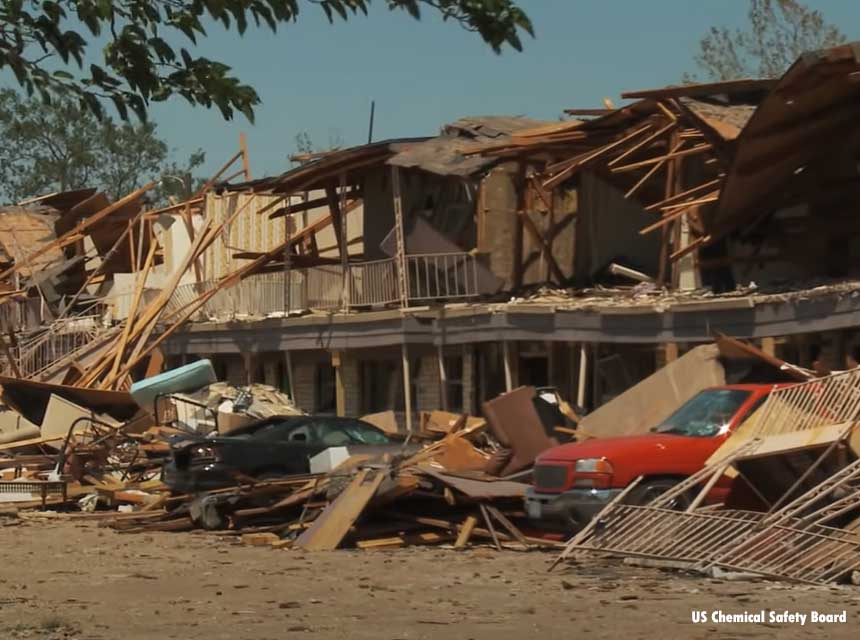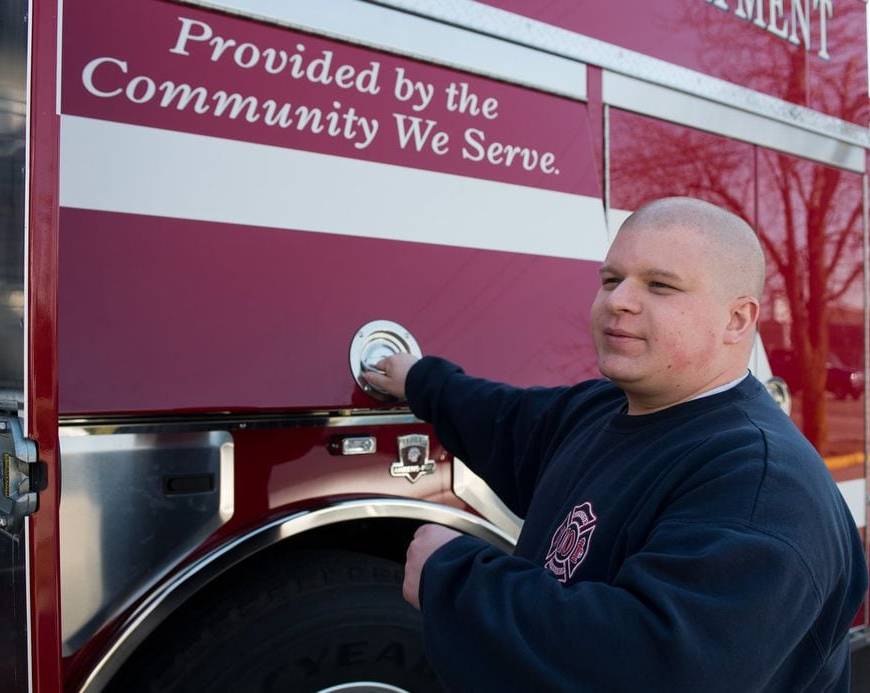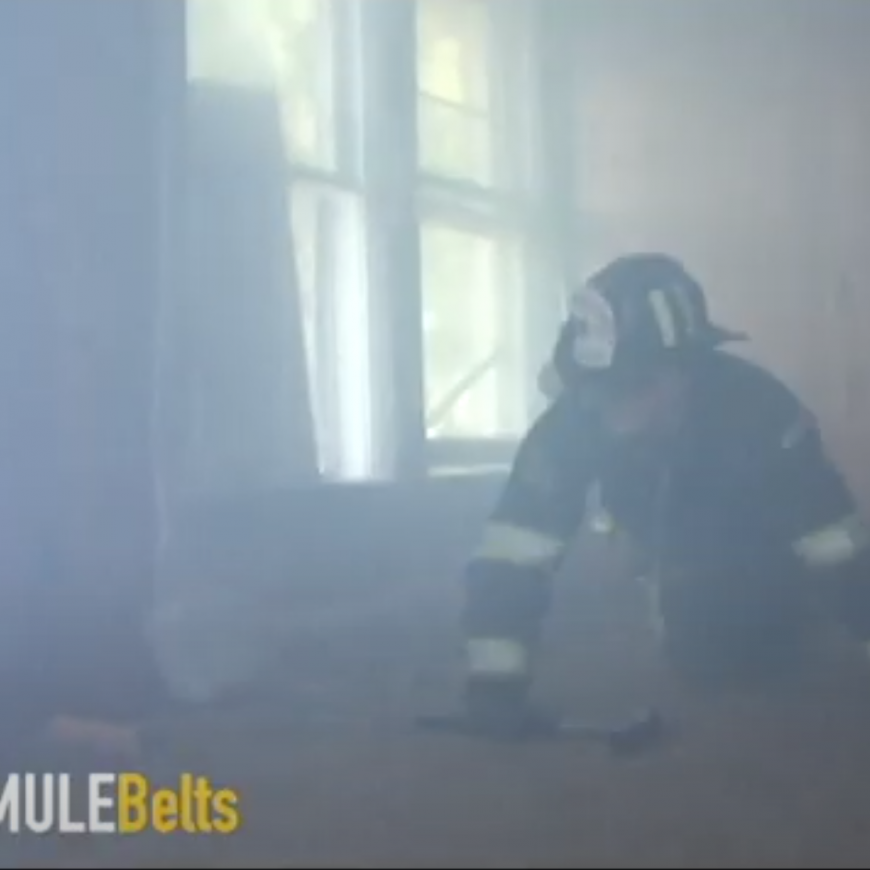Almost 10 years after the West (TX) explosion, no substantive changes have been enacted to protect the public and firefighters from a similar disaster
I do not personally agree with the message in the title of this article, but this is, in effect, what the fire safety community has been saying for nearly a decade. You may not agree, either.
On the evening of April 17, 2013, the dry fertilizers storage building of the Adair Grain Co., located in West, Texas, caught fire. It held around 30 tons of ammonium nitrate, plus some other fertilizers and some other agricultural goods. After burning for more than a half-hour, the facility exploded [1, 2]. The explosion killed 15 persons, injured more than 200, and destroyed two schools, a nursing home, and numerous other structures. The majority (10) of the victims were firefighters who were either volunteers of the local fire department or had arrived to assist. This was one of the most tragic incidents in the U.S. in which multiple firefighters lost their lives.
- Ammonium Nitrate: Tragic Lessons Still to Be Learned
- Ammonium Nitrate Explosions: Common Factors in Major Disasters
- Firefighter LODDs: Explosion in West, Texas: Lessons Learned from Multiple Deaths
I was hired as an expert in fire and explosion science to help figure out what happened and why. Even though I was not retained to help formulate any strategies for avoiding future disasters, as a responsible safety professional, I felt it incumbent on me to do so. In the aftermath, I published two papers [3, 4] explaining the science of ammonium nitrate explosions. More importantly, I published 10 other papers [5, 6, 7, 8, 9, 10, 11, 12, 13, 14] that focused solely on giving advice how such disasters can be prevented from occurring in the future.
The facility at West, Texas, is long gone, so why should we care? We should care because, according to a federal government study, there are more than 1,300 facilities nationwide that store significant quantities of ammonium nitrate [15]. The overwhelming number of these are old and of wood construction, much like was the case at West. An incident can occur at any of those that would be similar to the one at West. The outcome, in such a case, would also likely be similar: a multitude of firefighters killed, along with civilians killed and massive community damage. We cannot bring back the firefighters at West. But don’t we owe something to the firefighters of the other communities that have such extremely hazardous facilities, so that they would not needlessly sacrifice their lives?
Since this is the 10-year anniversary of the West disaster, it is crucial to point out that almost nothing of substance was done in the intervening decade to make such tragic loss of life less likely. The most galling is the Emergency Response Guidebook (ERG). The failures of that document [4] can be viewed as the proximate cause (as distinguished from root cause) of the West disaster. The actions of the West firefighters were consistent with the recommendations of the ERG, yet they got killed. A sensible person would conclude that, as a result, the document is tragically flawed and in dire need of improvement. But when I pointed this out, I got pushback [16], not any positive action. This is unconscionable. The benefit/cost ratio of making needed improvements there would be off the charts, yet no action was deemed acceptable by those involved with it.
The ERG is where the rubber meets the road with regards to fire departments responding to hazmat incidents. But let’s look now at the root cause. Ammonium nitrate is noncombustible; it cannot ignite, and it cannot burn. But it can explode when presented with a large, uncontrolled fire adjacent to it. Theoretically, ammonium nitrate can explode due to other causes. However, my extensive survey showed [10], in fact, that every single disaster which involved ammonium nitrate in storage or in transport had only one cause—an uncontrolled adjacent fire. This conclusion also excludes situations where other explosives or explosive materials were stored in proximity.
The lessons learned tell us that an ammonium nitrate storage facility will not explode, if (a) an uncontrolled fire is precluded and (b) other explosive goods are not stored in the same place. The second of these would be very simple to do by regulatory fiat, yet it appears that this was not done in Beirut [17] nor in Tianjin [18]. Fortunately, the latter two were not incidents that affected American firefighters; it further appears that such hazards are not common in the U.S. Thus, the focus has to be on uncontrolled fire. When no codes or regulations exist, the dangers of uncontrolled fire are very real. Yet, we have known for maybe two centuries now how to absolutely preclude the possibility of uncontrolled fire. It is not difficult; it is simple. Only two things are required: (1) build the building out of noncombustible materials and (2) do not bring in any combustible goods into the facility. A small exception needs to be made for combustible materials in electrical wiring and such, but this kind of very limited material usage cannot result in an uncontrolled fire.
The building at West, Texas was built in the late 1960s and built almost entirely out of wood, apart from portions clad in steel siding. This is generally the cheapest form of construction if there are no governing building codes or other requirements. The problem is that almost all of the 1,300 facilities at risk are of identical construction.
Clearly a building cannot be replaced at zero cost. But the point to remember is that almost all of these facilities are old, and in many cases way beyond their economical lifetime. Thus it is hard to view that replacing them with safe structures (concrete domes are often used for such purposes) would be an unreasonable imposition. This is an area where the chemical manufacturers could help, but they have chosen not to. In many cases, chemical manufacturers practice a responsible-care policy. If a buyer wishes to buy a hazardous chemical, the company will not sell it to them without first having conducted an inspection of the facility and determined that the buyer can safely handle the product. If such an inspection had been conducted for the West, Texas, facility, the disaster would not have happened, since the manufacturers would not have delivered product to the facility. That particular facility was not an outlier—ammonium nitrate is sold daily to buyers whose facilities have not been inspected and determined to be of adequate fire safety.
The discussion thus far has been on ammonium nitrate fires and explosions in buildings. Yet the loss record [10] indicates that many tragic incidents have also occurred in transportation. Unlike in buildings, where combustibles can be readily eliminated if there is a will to do so, in most cases combustibles (e.g., diesel fuel) cannot be eliminated from transportation. An additional strategy is needed for this protection. Calcium ammonium nitrate (CAN) is a related chemical fertilizer which has never exploded in any transport or storage accident. It is a viable substitute for ammonium nitrate and a number of countries (e.g., Germany, The Netherlands) have banned use of ammonium nitrate fertilizers, with farmers migrating to use of CAN. There is a slight cost penalty associated with such a change, but this is not significant enough to have precluded the switchover in the countries that have done this. It also must be presumed that cost in the U.S. would be small, but this cannot be directly quantified today. The reason is that, first, widespread distribution of CAN must be made available; economics of goods in limited supply cannot be extrapolated to a product which becomes in widespread use.
The only positive response to the West disaster was from the National Fire Protection Association (NFPA), which proceeded to revise the pertinent code, NFPA 400 [19]. However, in my view, this was window-dressing and not a substantive improvement of safety [11]. There are many reasons for this, but the main ones are that (1) NFPA 400 would only apply where there is a building code and an authority having jurisdiction, and (2) the updated provisions still do not forbid existing wood building and wood storage bins. If the building at Adair Grain Co. were still standing, the updated NFPA 400 would not have required that it be replaced by a noncombustible one.
On the federal level, the Occupational Safety and Health Administration (OSHA) is the primary agency which regulates safety in workplaces. They have some very old, very out-of-date regulations pertinent to ammonium nitrate and these were not upgraded in the aftermath of West. What is worse is that the agency issued an announcement containing false information [20].
The tragic incident on April 17, 2013, resulted in lives lost for 10 firefighters. We cannot predict when or where in the U.S. the next serious ammonium nitrate incident will occur. But we may not sleep well if we realize that, 10 years later, the fire services are in exactly the same position. A similar incident would likely result in a similar outcome. So, if nothing continues to be done, the message is clear: Protecting lives of firefighters is not necessary.
References
[1]. Firefighters and Civilians Injured in West (TX) Plant Explosion, FireEngineering.com (17 April 2013).
[2]. West Fertilizer Company Fire and Explosion (15 Fatalities, More Than 260 Injured), Report 2013-02-I-TX, US Chemical Safety and Hazard Investigation Board, Washington (2016).
[3]. Babrauskas, V., and Leggett, D., Thermal Decomposition of Ammonium Nitrate, Fire & Materials 44, 250-268 (2020).
[4]. Babrauskas, V., UN Test O.1 Errors in Quantifying the Behavior of Solid Oxidizers, J. Loss Prevention in the Process Industries 39, 1-6 (2016).
[5]. Babrauskas, V., Fire Safety Is the Key to Ammonium Nitrate Explosion Safety, Process Safety Progress 39 (2020). https://doi.org/10.1002/prs.12200
[6]. Babrauskas, V., The Emergency Response Guidebook (ERG): Not Good Enough, Not Safe Enough, Fire Engineering 173:11, 55-58 (Nov. 2020).
[7]. Babrauskas, V., An Avoidable Tragedy (West, Texas Ammonium Nitrate Disaster), Fire Protection Engineering, No. 77, 24-26, 28, 30-31 (Q1 2018).
[8]. Babrauskas, V., The Ammonium Nitrate Explosion at West, Texas: A Disaster That Could Have Been Avoided, Fire & Materials 42, 164-172 (2018).
[9]. Babrauskas, V., The West, Texas Ammonium Nitrate Explosion: A Failure of Regulation, J. Fire Sciences 35, 396-414 (2017).
[10]. Babrauskas, V., The West, Texas Ammonium Nitrate Explosion: A Failure of Regulation, pp. 49-65 in Proc. Intl. Symp. on Fire Investigation Science & Technology – ISFI 2016, NAFI, Sarasota FL (2016).
[11]. Babrauskas, V., The Ammonium Nitrate Explosion at West, Texas: A Disaster That Could Have Been Avoided, pp. 1-11 in Interflam 2016, Interscience Communications Ltd., London (2016).
[12]. Babrauskas, V., Explosions of Ammonium Nitrate Fertilizer in Storage or Transportation Are Preventable Accidents, J. Hazardous Materials 304, 134-149 (2016).
[13]. Babrauskas, V., Will Firefighters Be Any Safer Under the New Hazardous Materials Code? Fire Engineering 168:11, 66-70 (Nov. 2015).
[14]. Babrauskas, V., Ammonium Nitrate: Tragic Lessons Still to Be Learned, Fire Engineering online, 8/27.2020.
[15]. Chemical Safety – Actions Needed to Improve Federal Oversight of Facilities with Ammonium Nitrate (GAO-14-274), US Government Accountability Office, Washington (2014).
[16]. Noll, G. G., et al., ERG Not Good Enough? Fire Engineering 175:2, 22-25 (Feb. 2021).
[17]. Pasman, H. J., Fouchier, C., Park, S., Quddus, N., and Laboureur, D., Beirut Ammonium Nitrate Explosion: Are Not We Really Learning Anything? Process Safety Progress 39, e12203 (2020).
[18]. Yu, G., et al., Holistic Case Study on the Explosion of Ammonium Nitrate in Tianjin Port, Sustainability 14, 3429 (2022).
[19]. Hazardous Materials Code (NFPA 400), National Fire Protection Assn., Quincy MA.
[20]. Guidance on the Ammonium Nitrate Storage Requirements in 29 CFR 1910.109(i), OSHA, Washington (3 Dec. 2014).
Vyto Babrauskas, Ph.D., is known for his research contributing to the field of fire investigation. He is the author of Ignition Handbook, Electrical Fires and Explosions, and Smoldering Fires. His firm Fire Science and Technology Inc. is located in Clarkdale, Arizona.
CONTACT PACMULE BELTS AT 630-868-3877 OR CLICK HERE



